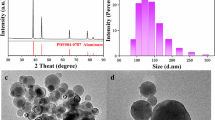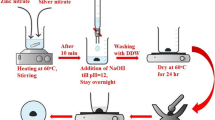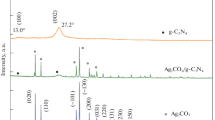Abstract
The issue of water pollution has emerged as a formidable challenge, prompting a pressing need for solutions. The utilization of metal nanoparticles with surface plasmon resonance and semiconductor composite photocatalysts is regarded as a highly effective approach to solve this problem. g-C3N4 is an effective catalyst for the degradation of organic pollutants. Its photocatalytic performance is usually enhanced by the use of the noble metal Au Ag. However, the high cost of these materials limits their application. In this study, we present the synthesis of Al NPs/g-C3N4 nanocomposites using the bridging effect of ligands. The characterized of transmission electron microscopy (TEM), X-ray diffractometer (XRD) and ultraviolet-visible spectroscopy (UV-Vis) proved that Al NPs/g-C3N4 with a wider light absorption range were successfully synthesized. The effects of ligands, (glutathione (GSH), glutamic acid (GAG), and cysteine (CYS)), Al diameter (40 to 200 nm) and the ratio of Al to g-C3N4 (1:1 to 5:1) on the photocatalytic degradation of methylene blue (MB) by Al NPs/g-C3N4 were also evaluated. The results showed that the optimum degradation efficiency of Al NPs/g-C3N4 for MB at 5 mg/L reached 100% within 60 min, which was 11 times higher than that of pure g-C3N4. The principal analysis of Al enhancing the photocatalytic performance of g-C3N4 was studied through transient photocurrent spectroscopy (TPC), electrochemical impedance spectroscopy (EIS), and steady-state transient fluorescence spectroscopy (PL). The results confirmed that hot carriers generated by localized surface plasmon resonance (LSPR) of Al nanoparticles increase the carrier concentration. In addition, the Schottky barrier generated by Al and g-C3N4 could also improve the carrier separation rate and increase the carrier lifetime. This work is expected to solve the problem of organic wastewater treatment and lay the foundation for subsequent research on photocatalysis.
Graphical abstract








Similar content being viewed by others
Data availability
Not applicable.
References
Alharbi NS, Hu B, Hayat T, Rabah SO, Wang X (2020) Efficient elimination of environmental pollutants through sorption-reduction and photocatalytic degradation using nanomaterials. Front Chem Sci Eng 14:1124–1135. https://doi.org/10.1007/s11705-020-1923-z
AlSalhi MS, Sakthisabarimoorthi A, Devanesan S, Martin Britto Dhas SA, Jose M (2019) Study on photocatalytic and impedance spectroscopy investigations of composite CuO/ZnO nanoparticles. J Mater Sci Mater Electron 30:13708–13718. https://doi.org/10.1007/s10854-019-01752-9
Ateia M, Alalm MG, Awfa D, Johnson MS, Yoshimura C (2020) Modeling the degradation and disinfection of water pollutants by photocatalysts and composites: A critical review. Sci Total Environ 698:134197. https://doi.org/10.1016/j.scitotenv.2019.134197
Bashir M, Batool M, Arif N, Tayyab M, Zeng YJ, Zafar MN (2023) Strontium-based nanomaterials for the removal of organic/inorganic contaminants from water: A review. Coord Chem Rev 492:215286. https://doi.org/10.1016/j.ccr.2023.215286
Bu Y, Chen Z, Li W (2014) Using electrochemical methods to study the promotion mechanism of the photoelectric conversion performance of Ag-modified mesoporous g-C3N4 heterojunction material. Appl Catal B 144:622–630. https://doi.org/10.1016/j.apcatb.2013.07.066
Chen Y, Xin X, Zhang N, Xu YJ (2017) Aluminum-Based Plasmonic Photocatalysis. Part Part Syst Charact 34(8):1600357. https://doi.org/10.1002/ppsc.201600357
Dong F, Zhao Z, Sun Y, Zhang Y, Yan S, Wu Z (2015) An advanced semimetal-organic Bi spheres-g-C3N4 nanohybrid with SPR-enhanced visible-light photocatalytic performance for NO purification. Environ Sci Technol 49(20):12432–12440. https://doi.org/10.1021/acs.est.5b03758
Faisal M, Jalalah M, Harraz FA, El-Toni AM, Khan A, Al-Assiri MS (2020) Au nanoparticles-doped g-C3N4 nanocomposites for enhanced photocatalytic performance under visible light illumination. Ceramics Int 46(14):22090–22101. https://doi.org/10.1016/j.ceramint.2020.05.250
Fu J, Yu J, Jiang C, Cheng B (2018) g-C3N4-Based heterostructured photocatalysts. Adv Energy Mater 8(3):1701503. https://doi.org/10.1002/aenm.201701503
Gu JW, Guo RT, Miao YF, Liu YZ, Wu GL, Duan CP, Pan WG (2021) Noble-metal-free Bi/g-C3N4 nanohybrids for efficient photocatalytic CO2 reduction under simulated irradiation. Energy Fuels 35(12):10102–10112. https://doi.org/10.1021/acs.energyfuels.1c00439
Guo S, Li X, Li J (2021) Boosting photocatalytic hydrogen production from water by photothermally induced biphase systems. Nat Commun 12:1343. https://doi.org/10.1038/s41467-021-21526-4
Guo Z, Dai F, Yin H, Zhang M, Xing J, Wang L (2022) The dual role of Au nanoparticles in the surface plasmon resonance enhanced photocatalyst Au/g-C3N4. Colloid Interface Sci Commun 48:100615. https://doi.org/10.1016/j.colcom.2022.100615
Hao Q, Wang C, Huang H, Li W, Du D, Han D, Chu PK (2015) Aluminum plasmonic photocatalysis. Sci Rep 5(1):15288. https://doi.org/10.1038/srep15288
Hossein K, Masoud SN, Hamed S, Hossein SH (2017) Facile reduction of graphene using urea in solid phase and surface modification by n-doped graphene quantum dots for adsorption of organic dyes. Diamond Relat Mater 79:133–144. https://doi.org/10.1016/j.diamond.2017.09.011
Hu J, Chen L, Lian Z, Cao M, Li H, Sun W, Zeng H (2012) Deep-ultraviolet-blue-light surface plasmon resonance of Al and Alcore/Al2O3shell in spherical and cylindrical nanostructures. J Phys Chem C 116(29):15584–15590. https://doi.org/10.1021/jp305844g
Iervolino G, Zammit I, Vaiano V, Rizzo L (2019) Limitations and prospects for wastewater treatment by UV and visible-light-active heterogeneous photocatalysis: A critical review. Top Curr Chem 378(1):7. https://doi.org/10.1007/s41061-019-0272-1
Koe W, Lee J, Chong W, Pang Y, Sim L (2020) An overview of photocatalytic degradation: photocatalysts, mechanisms, and development of photocatalytic membrane. Environ Sci Pollut Res 27:2522–2565. https://doi.org/10.1007/s11356-019-07193-5
Li Z, Zhang QW, Liu XZ (2018) One-step mechanochemical synthesis of plasmonic Ag/Zn-Al LDH with excellent photocatalytic activity. J Mater Sci 53:12795–12806. https://doi.org/10.1007/s10853-018-2537-4
Li X, Liu C, Wu D, Li J, Huo P, Wang H (2019) Improved charge transfer by size-dependent plasmonic Au on C3N4 for efficient photocatalytic oxidation of RhB and CO2 reduction. Chin J Catal 40(6):928–939. https://doi.org/10.1016/S1872-2067(19)63347-4
Liu X, Ma R, Zhuang L, Hu B, Chen J, Liu X, Wang X (2021a) Recent developments of doped g-C3N4 photocatalysts for the degradation of organic pollutants. Crit Rev Environ Sci Technol 51(8):751–790. https://doi.org/10.1080/10643389.2020.1734433
Liu Y, Zhu Q, Tayyab M, Zhou L, Lei J, Zhang J (2021b) Single-atom Pt loaded zinc vacancies ZnO-ZnS induced Type-V electron transport for efficiency photocatalytic H2 evolution. Solar RRL 5(11):2100536. https://doi.org/10.1002/solr.202100536
Mahnaz A, Masoud SN, Ahmad A, Tahereh G (2017) Removal of malachite green (a toxic dye) from water by cobalt ferrite silica magnetic nanocomposite: Herbal and green sol-gel autocombustion synthesis. Int J Hydrogen Energy 42(39):24846–24860. https://doi.org/10.1016/j.ijhydene.2017.08.077
Masoud SN, Mahnaz D, Fatemeh D (2009) Pure cubic ZrO2 nanoparticles by thermolysis of a new precursor. Polyhedron 28(14):3005–3009. https://doi.org/10.1016/j.poly.2009.06.032
Meng S, Ye X, Ning X, Xie M, Fu X, Chen S (2016) Selective oxidation of aromatic alcohols to aromatic aldehydes by BN/metal sulfide with enhanced photocatalytic activity. Appl Catal B 182:356–368. https://doi.org/10.1016/j.apcatb.2015.09.030
Mokhtar PK, Masoud SN, Mostafa HM (2014) Facile microwave synthesis, characterization, and solar cell application of selenium nanoparticles. J Alloys Compd 617:627–632. https://doi.org/10.1016/j.jallcom.2014.07.174
Nadia MC, Eric L, Guorui L (2022) Worldwide cases of water pollution by emerging contaminants: a review. Environ Chem Lett 20:2311–2338. https://doi.org/10.1007/s10311-022-01447-4
Nanda B, Rath D (2020) Surface-plasmon-resonance induced photocatalysis by Cu(0)/Cu(II)@g-C3N4/MCM-41 nanosphere towards phenol oxidation under solar light. Mater Today Proc 30:294–298. https://doi.org/10.1016/j.matpr.2020.01.537
Niu J, Wang K, Ma Z, Yang F, Zhang Y (2020) Application of g-C3N4 matrix composites photocatalytic performance from degradation of antibiotics. ChemistrySelect 5(40):12353–12364. https://doi.org/10.1002/slct.202003407
Panahi A, Monsef R, Dawi EA, Hussein AS, Salavati-Niasari M (2023) Green auto-combustion synthesis and characterization of TmVO4 nanostructures in the presence carbohydrate sugars and their application as visible-light photocatalyst. Solar Energy 258:372–382. https://doi.org/10.1016/j.solener.2023.04.030
Papaoikonomou L, Labanaris K, Kaderides K, Goula AM (2021) Adsorption-desorption of phenolic compounds from olive mill wastewater using a novel low-cost biosorbent. Environ Sci Pollut Res 28(19):24230–24244. https://doi.org/10.1007/s11356-019-07277-2
Patial S, Raizada P, Hasija V, Singh P, Thakur VK, Nguyen VH (2021) Recent advances in photocatalytic multivariate metal organic frameworks-based nanostructures toward renewable energy and the removal of environmental pollutants. Mater Today Energy 19:100589. https://doi.org/10.1016/j.mtener.2020.100589
Patnaik S, Sahoo DP, Parida K (2021) Recent advances in anion doped g-C3N4 photocatalysts: a review. Carbon 172:682–711. https://doi.org/10.1016/j.carbon.2020.10.073
Rabell GO, Cruz MRA, Juárez-Ramírez I (2022) Photoelectrochemical (PEC) analysis of ZnO/Al photoelectrodes and its photocatalytic activity for hydrogen production. Int J Hydrogen Energy 47(12):7770–7782. https://doi.org/10.1016/j.ijhydene.2021.12.107
Sahar ZA, Mahin B, Masoud SN (2021) Enhanced visible-light-driven photocatalytic performance for degradation of organic contaminants using PbWO4 nanostructure fabricated by a new, simple and green sonochemical approach. Ultrason Sonochem 72:105420. https://doi.org/10.1016/j.ultsonch.2020.105420
Sun Z, Fang W, Zhao L, Wang H (2020) 3D porous Cu-NPs/g-C3N4 foam with excellent CO2 adsorption and Schottky junction effect for photocatalytic CO2 reduction. Appl Surf Sci 504:144347. https://doi.org/10.1016/j.apsusc.2019.144347
Tahir B, Tahir M, Amin NAS (2017) Photo-induced CO2 reduction by CH4/H2O to fuels over Cu-modified g-C3N4 nanorods under simulated solar energy. Appl Surf Sci 419:875–885. https://doi.org/10.1016/j.apsusc.2017.05.117
Tang W, Pei Y, Zheng H, Zhao Y, Shu L, Zhang H (2022) Twenty years of china's water pollution control: experiences and challenges. Chemosphere 295:133875. https://doi.org/10.1016/j.chemosphere.2022.133875
Tayyab M, Liu YJ, Liu ZG (2022) One-pot in-situ hydrothermal synthesis of ternary In2S3/Nb2O5/Nb2C Schottky/S-scheme integrated heterojunction for efficient photocatalytic hydrogen production. J Colloid Interface Sci 628(Pt B):500–512. https://doi.org/10.1016/j.jcis.2022.08.071
Tayyab M, Kulsoom UE, Rafique H, Mughal EU, Aman S, Mushtaq A, Noureen L (2023) Emerging MXene-Derived photocatalysts for harvesting solar energy into chemical energy. Nanomater Energy Appl 16. https://doi.org/10.1201/9781003364825-8
Teymourinia H, Salavati NM, Amiri O, Safardoust HH (2017) Synthesis of graphene quantum dots from corn powder and their application in reduce charge recombination and increase free charge carriers. J Mol Liq 242:447–455. https://doi.org/10.1016/j.molliq.2017.07.052
Wang W, Bai X, Ci Q, Du L, Ren X, Phillips DL (2021) Near-field drives long-lived shallow trapping of polymeric C3N4 for efficient photocatalytic hydrogen evolution. Adv Funct Mater 31(35):2103978. https://doi.org/10.1002/adfm.202103978
Wei Z, Liu J, Fang W, Xu M, Qin Z, Jiang Z, Shangguan W (2019) Photocatalytic hydrogen evolution with simultaneous antibiotic wastewater degradation via the visible-light-responsive bismuth spheres-g-C3N4 nanohybrid: Waste to energy insight. Chem Eng J 358:944–954. https://doi.org/10.1016/j.cej.2018.10.096
Wen J, Xie J, Chen X, Li X (2017) A review on g-C3N4-based photocatalysts. Appl Surf Sci 391:72–123. https://doi.org/10.1016/j.apsusc.2016.07.030
Xu J, Wang G, Fan J, Liu B, Cao S, Yu J (2015) g-C3N4 modified TiO2 nanosheets with enhanced photoelectric conversion efficiency in dye-sensitized solar cells. J Power Sources 274:77–84. https://doi.org/10.1016/j.jpowsour.2014.10.033
Xu XT, Huang Y, Dai K, Wang ZL, Zhang JF (2023) Non-noble-metal CuSe promotes charge separation and photocatalytic CO2 reduction on porous g-C3N4 nanosheets. Sep Purif Technol 317:123887. https://doi.org/10.1016/j.seppur.2023.123887
Yu H, Zhang P, Lu S, Yang S, Peng F, Chang WS, Liu K (2020) Synthesis and multipole plasmon resonances of spherical aluminum nanoparticles. J Phys Chem Lett 11(15):5836–5843. https://doi.org/10.1021/acs.jpclett.0c01754
Yue WH, Xu ZH, Tayyab M, Wang LZ, Ye ZW, Zhang JL (2023) Schottky junction enhanced H2 evolution for graphitic carbon nitride-NiS composite photocatalysts. J Colloid Interface Sci 657:133–141. https://doi.org/10.1016/j.jcis.2023.11.092
Funding
This work is supported by the Developing Project of Science and Technology of Jilin Province (20220101021JC), the Project of Education Department of Jilin Province (JJKH20230794KJ). The National Natural Science Foundation of China (62174015), and the “111” Project of China (D17017).
Author information
Authors and Affiliations
Contributions
All authors contributed to the study conception and design. Material preparation, data sorting and writing-manuscript preparation by Haiyu Li. Conceptualization, funding acquisition, supervision, writing-review and editing by Mingze Xu. Investigation, resources by Tingsong Zhang. All authors commented on previous versions of the manuscript. All authors read and approved the final manuscript.
Corresponding author
Ethics declarations
Ethics approval and consent to participate
Not applicable.
Consent for publication
Not applicable.
Competing interests
The authors declare no competing interests.
Additional information
Responsible Editor: George Z. Kyzas
Publisher’s Note
Springer Nature remains neutral with regard to jurisdictional claims in published maps and institutional affiliations.
Rights and permissions
Springer Nature or its licensor (e.g. a society or other partner) holds exclusive rights to this article under a publishing agreement with the author(s) or other rightsholder(s); author self-archiving of the accepted manuscript version of this article is solely governed by the terms of such publishing agreement and applicable law.
About this article
Cite this article
Li, ., Xu, M. & Zhang, T. g-C3N4 modified with non-precious metal Al with LSPR as an efficient visible light catalyst. Environ Sci Pollut Res 31, 16795–16804 (2024). https://doi.org/10.1007/s11356-024-32017-6
Received:
Accepted:
Published:
Issue Date:
DOI: https://doi.org/10.1007/s11356-024-32017-6




